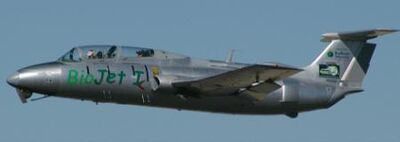
BioJet, one of the first bio-fuelled fighter aircraft.
The Aero L-29 Delfín (English: Dolphin, NATO reporting name: Maya) is a military jet trainer aircraft that became the standard jet trainer for the air forces of Warsaw Pact nations in the 1960s. It was Czechoslovakia's first locally designed and built jet aircraft.
Design and development[]
In the late 1950s, the Soviet Air Force was seeking a jet-powered replacement for its fleet of piston-engined trainers, and this requirement was soon broadened to finding a trainer aircraft that could be adopted in common by Eastern Bloc air forces. Aero's response, the prototype XL-29 designed by Z. Rublič and K. Tomáš first flew on 5 April 1959, powered by a British Bristol Siddeley Viper engine. The second prototype was powered by the Czech-designed M701 engine, which was used in all subsequent aircraft.
The basic design concept was to produce a straightforward, easy-to-build and operate aircraft. Simplicity and ruggedness were stressed with manual flight controls, large flaps and the incorporation of perforated airbrakes on the fuselage sides providing stable and docile flight characteristics, leading to an enviable safety record for the type. The sturdy L-29 was able to operate from grass, sand or unprepared fields. Both student pilot and instructor had ejection seats, and were positioned in tandem, under separate canopies with a slightly raised instructor position.
In 1961, the L-29 was evaluated against the PZL TS-11 Iskra and Yakovlev Yak-30 and emerged the winner. Poland chose to pursue the development of the TS-11 Iskra anyway, but all other Warsaw Pact countries adopted the Delfin under the agreements of COMECON.

Production began April 1963 and continued for 11 years, with 3,600 eventually built until 1974. A dedicated, single-seat, aerobatic version was developed as the L-29A Akrobat. A reconnaissance version with nose-mounted cameras was built as the L-29R
Specifications[]
General characteristics[]
- Crew: 2: student and instructor
- Length: 10.81 m (35 ft 5½ in)
- Wingspan: 10.29 m (33 ft 9 in)
- Height: 3.13 m (10 ft 3 in)
- Wing area: 19.8 m² (213 ft²)
- Empty weight: 2,280 kg (5,027 lb)
- Loaded weight: 3,280 kg (7,231 lb)
- Max. takeoff weight: 3,540 kg (7,804 lb)
- Powerplant: 1 × Motorlet M-701C 500 turbojet, 8.7 kN (1,960 lbf)
Performance[]
- Never exceed speed: 820 km/h (442 knots, 510 mph)
- Maximum speed: 655 km/h (353 knots, 407 mph) at 5,000 m (16,400 ft)
- Stall speed: 130 km/h (71 knots, 81 mph) flaps down
- Range: 894 km (480 nmi, 555 mi)with tip tanks
- Endurance: 2 hours 30 min
- Service ceiling: 11,000 m (36,100 ft)
- Rate of climb: 14.0 m/s (2,755 ft/min)